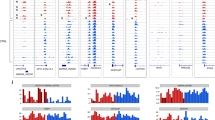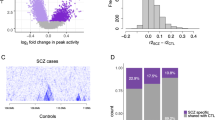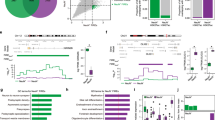Abstract
Chromosomal organization, scaling from the 147-base pair (bp) nucleosome to megabase-ranging domains encompassing multiple transcriptional units, including heritability loci for psychiatric traits, remains largely unexplored in the human brain. In this study, we constructed promoter- and enhancer-enriched nucleosomal histone modification landscapes for adult prefrontal cortex from H3-lysine 27 acetylation and H3-lysine 4 trimethylation profiles, generated from 388 controls and 351 individuals diagnosed with schizophrenia (SCZ) or bipolar disorder (BD) (n = 739). We mapped thousands of cis-regulatory domains (CRDs), revealing fine-grained, 104–106-bp chromosomal organization, firmly integrated into Hi-C topologically associating domain stratification by open/repressive chromosomal environments and nuclear topography. Large clusters of hyper-acetylated CRDs were enriched for SCZ heritability, with prominent representation of regulatory sequences governing fetal development and glutamatergic neuron signaling. Therefore, SCZ and BD brains show coordinated dysregulation of risk-associated regulatory sequences assembled into kilobase- to megabase-scaling chromosomal domains.
This is a preview of subscription content, access via your institution
Access options
Access Nature and 54 other Nature Portfolio journals
Get Nature+, our best-value online-access subscription
$29.99 / 30 days
cancel any time
Subscribe to this journal
Receive 12 print issues and online access
$209.00 per year
only $17.42 per issue
Buy this article
- Purchase on Springer Link
- Instant access to full article PDF
Prices may be subject to local taxes which are calculated during checkout






Similar content being viewed by others

Data availability
Raw data (FASTQ files) and processed data (BigWig files, metadata, peaks and raw and normalized count matrices) have been deposited in Synapse under synID syn25705564. Browsable UCSC genome browser tracks of our processed ChIP-seq data are available as a resource at EpiDiff Phase 2 http://genome.ucsc.edu/s/girdhk01/EpiDiff_Phase2.
External validation sets used in the study are as follows: H3K27ac ChIP-seq fetal-specific peaks: spatio-temporal enrichment of H3K27ac peaks table from http://development.psychencode.org/#; RoadMap Epigenome Project H3K27ac, H3K4me3 tissue ChIP-seq peaks, chromHMM states on E073 and fetal male E081 and fetal female E082 (https://egg2.wustl.edu/roadmap/data/byFileType/chromhmmSegmentations/ChmmModels/coreMarks/jointModel/final/); and CTCF ChIP-seq on human neural cell (Gene Expression Omnibus GSE127577). TruSeq3-PE.fa file was downloaded from the adaptor folder under the Trimmomatic repository: https://github.com/timflutre/trimmomatic/blob/master/adapters/TruSeq3-PE.fa.
The source data described in this manuscript are available via the PsychENCODE Knowledge Portal (https://psychencode.synapse.org/). The PsychENCODE Knowledge Portal is a platform for accessing data, analyses and tools generated through grants funded by the National Institute of Mental Health PsychENCODE program. Data are available for general research use according to the following requirements for data access and data attribution: https://psychencode.synapse.org/DataAccess.
Code availability
All publicly available software used is noted in the Methods. We used decorate software to call CRDs: https://github.com/GabrielHoffman/decorate.
References
Dixon, J. R. et al. Chromatin architecture reorganization during stem cell differentiation. Nature 518, 331–336 (2015).
Girdhar, K. et al. Cell-specific histone modification maps in the human frontal lobe link schizophrenia risk to the neuronal epigenome. Nat. Neurosci. 21, 1126–1136 (2018).
Cheung, I. et al. Developmental regulation and individual differences of neuronal H3K4me3 epigenomes in the prefrontal cortex. Proc. Natl Acad. Sci. USA 107, 8824–8829 (2010).
Khan, A., Mathelier, A. & Zhang, X. Super-enhancers are transcriptionally more active and cell type-specific than stretch enhancers. Epigenetics 13, 910–922 (2018).
Network and Pathway Analysis Subgroup of Psychiatric Genomics Consortium. Psychiatric genome-wide association study analyses implicate neuronal, immune and histone pathways. Nat. Neurosci. 18, 199–209 (2015).
Roussos, P. et al. A role for noncoding variation in schizophrenia. Cell Rep. 9, 1417–1429 (2014).
Takata, A. et al. Loss-of-function variants in schizophrenia risk and SETD1A as a candidate susceptibility gene. Neuron 82, 773–780 (2014).
Fullard, J. F. et al. An atlas of chromatin accessibility in the adult human brain. Genome Res. 28, 1243–1252 (2018).
Hauberg, M. E. et al. Common schizophrenia risk variants are enriched in open chromatin regions of human glutamatergic neurons. Nat. Commun. 11, 5581 (2020).
Smigielski, L., Jagannath, V., Rössler, W., Walitza, S. & Grünblatt, E. Epigenetic mechanisms in schizophrenia and other psychotic disorders: a systematic review of empirical human findings. Mol. Psychiatry 25, 1718–1748 (2020).
Fromer, M. et al. Gene expression elucidates functional impact of polygenic risk for schizophrenia. Nat. Neurosci. 19, 1442–1453 (2016).
Hoffman, G. E. et al. CommonMind Consortium provides transcriptomic and epigenomic data for schizophrenia and bipolar disorder. Sci. Data 6, 180 (2019).
Hauberg, M. E. et al. Differential activity of transcribed enhancers in the prefrontal cortex of 537 cases with schizophrenia and controls. Mol. Psychiatry 24, 1685–1695 (2019).
Kozlenkov, A. et al. A unique role for DNA (hydroxy)methylation in epigenetic regulation of human inhibitory neurons. Sci. Adv. 4, eaau6190 (2018).
Wong, A. H. C. et al. Association between schizophrenia and the syntaxin 1A gene. Biol. Psychiatry 56, 24–29 (2004).
Bryois, J. et al. Evaluation of chromatin accessibility in prefrontal cortex of individuals with schizophrenia. Nat. Commun. 9, 3121 (2018).
Finucane, H. K. et al. Partitioning heritability by functional annotation using genome-wide association summary statistics. Nat. Genet. 47, 1228–1235 (2015).
Madani Tonekaboni, S. A., Mazrooei, P., Kofia, V., Haibe-Kains, B. & Lupien, M. Identifying clusters of cis-regulatory elements underpinning TAD structures and lineage-specific regulatory networks. Genome Res. 29, 1733–1743 (2019).
Bendl, J. et al. The three-dimensional landscape of chromatin accessibility in Alzheimer’s disease. Preprint at https://www.biorxiv.org/content/10.1101/2021.01.11.426303v1 (2021).
Dong, P. et al. Population-level variation of enhancer expression identifies novel disease mechanisms in the human brain. Preprint at https://www.biorxiv.org/content/biorxiv/early/2021/06/11/2021.05.14.443421.full.pdf (2021).
Delaneau, O. et al. Chromatin three-dimensional interactions mediate genetic effects on gene expression. Science 364, eaat8266 (2019).
Waszak, S. M. et al. Population variation and genetic control of modular chromatin architecture in humans. Cell 162, 1039–1050 (2015).
Hoffman, G. E., Bendl, J., Girdhar, K. & Roussos, P. decorate: differential epigenetic correlation test. Bioinformatics 36, 2856–2861 (2020).
Ambroise, C., Dehman, A., Neuvial, P., Rigaill, G. & Vialaneix, N. Adjacency-constrained hierarchical clustering of a band similarity matrix with application to genomics. Algorithms Mol. Biol. 14, 22 (2019).
Beagan, J. A. & Phillips-Cremins, J. E. On the existence and functionality of topologically associating domains. Nat. Genet. 52, 8–16 (2020).
Nuebler, J., Fudenberg, G., Imakaev, M., Abdennur, N. & Mirny, L. A. Chromatin organization by an interplay of loop extrusion and compartmental segregation. Proc. Natl Acad. Sci. USA 115, E6697–E6706 (2018).
Kichaev, G. et al. Leveraging polygenic functional enrichment to improve GWAS power. Am. J. Hum. Genet. 104, 65–75 (2019).
Dixon, J. R. et al. Topological domains in mammalian genomes identified by analysis of chromatin interactions. Nature 485, 376–380 (2012).
Lazar, N. H. et al. Epigenetic maintenance of topological domains in the highly rearranged gibbon genome. Genome Res. 28, 983–997 (2018).
Hoffman, G. E. et al. Sex differences in the human brain transcriptome of cases with schizophrenia. Biol. Psychiatry 91, 92–101 (2022).
Li, M. et al. Integrative functional genomic analysis of human brain development and neuropsychiatric risks. Science 362, eaat7615 (2018).
Paulsen, J. et al. Chrom3D: three-dimensional genome modeling from Hi-C and nuclear lamin-genome contacts. Genome Biol. 18, 21 (2017).
Paulsen, J., Liyakat Ali, T. M. & Collas, P. Computational 3D genome modeling using Chrom3D. Nat. Protoc. 13, 1137–1152 (2018).
Tseng, C.-E. J. et al. In vivo human brain expression of histone deacetylases in bipolar disorder. Transl. Psychiatry 10, 224 (2020).
Gilbert, T. M. et al. PET neuroimaging reveals histone deacetylase dysregulation in schizophrenia. J. Clin. Invest. 129, 364–372 (2019).
Schroeder, F. A. et al. Expression of HDAC2 but not HDAC1 transcript is reduced in dorsolateral prefrontal cortex of patients with schizophrenia. ACS Chem. Neurosci. 8, 662–668 (2017).
Bahari-Javan, S. et al. HDAC1 links early life stress to schizophrenia-like phenotypes. Proc. Natl Acad. Sci. USA 114, E4686–E4694 (2017).
Jakovcevski, M. et al. Prefrontal cortical dysfunction after overexpression of histone deacetylase 1. Biol. Psychiatry 74, 696–705 (2013).
Schroeder, F. A., Lin, C. L., Crusio, W. E. & Akbarian, S. Antidepressant-like effects of the histone deacetylase inhibitor, sodium butyrate, in the mouse. Biol. Psychiatry 62, 55–64 (2007).
de la Fuente Revenga, M. et al. HDAC2-dependent antipsychotic-like effects of chronic treatment with the HDAC inhibitor SAHA in mice. Neuroscience 388, 102–117 (2018).
Thomas, E. A. Histone posttranslational modifications in schizophrenia. Adv. Exp. Med. Biol. 978, 237–254 (2017).
Shulha, H. P., Cheung, I., Guo, Y., Akbarian, S. & Weng, Z. Coordinated cell type–specific epigenetic remodeling in prefrontal cortex begins before birth and continues into early adulthood. PLoS Genetics 9, e1003433 (2013).
Connor, C. M. et al. Maternal immune activation alters behavior in adult offspring, with subtle changes in the cortical transcriptome and epigenome. Schizophr. Res. 140, 175–184 (2012).
Jaffe, A. E. et al. Mapping DNA methylation across development, genotype and schizophrenia in the human frontal cortex. Nat. Neurosci. 19, 40–47 (2016).
Hannon, E. et al. Methylation QTLs in the developing brain and their enrichment in schizophrenia risk loci. Nat. Neurosci. 19, 48–54 (2016).
Ruzicka, W. B. et al. Single-cell dissection of schizophrenia reveals neurodevelopmental-synaptic axis and transcriptional resilience. Preprint at https://www.medrxiv.org/content/10.1101/2020.11.06.20225342v1 (2020).
Dienel, S. J., Enwright, J. F., Hoftman, G. D. & Lewis, D. A. Markers of glutamate and GABA neurotransmission in the prefrontal cortex of schizophrenia subjects: disease effects differ across anatomical levels of resolution. Schizophr. Res. 217, 86–94 (2020).
Bonev, B. et al. Multiscale 3D genome rewiring during mouse neural development. Cell 171, 557–572 (2017).
Lomvardas, S. et al. Interchromosomal interactions and olfactory receptor choice. Cell 126, 403–413 (2006).
Quinodoz, S. A. et al. Higher-order inter-chromosomal hubs shape 3D genome organization in the nucleus. Cell 174, 744–757 (2018).
Khanna, N., Hu, Y. & Belmont, A. S. HSP70 transgene directed motion to nuclear speckles facilitates heat shock activation. Curr. Biol. 24, 1138–1144 (2014).
Ahanger, S. H. et al. Distinct nuclear compartment-associated genome architecture in the developing mammalian brain. Nat. Neurosci. 24, 1235–1242 (2021).
Legge, S. E. et al. Associations between schizophrenia polygenic liability, symptom dimensions, and cognitive ability in schizophrenia. JAMA Psychiatry 8, 1143–1151 (2021).
Wang, D. et al. Comprehensive functional genomic resource and integrative model for the human brain. Science 362, eaat8464 (2018).
Kundakovic, M. et al. Practical guidelines for high-resolution epigenomic profiling of nucleosomal histones in postmortem human brain tissue. Biol. Psychiatry 81, 162–170 (2017).
Jiang, Y., Matevossian, A., Huang, H.-S., Straubhaar, J. & Akbarian, S. Isolation of neuronal chromatin from brain tissue. BMC Neurosci. 9, 42 (2008).
Bolger, A. M., Lohse, M. & Usadel, B. Trimmomatic: a flexible trimmer for Illumina sequence data. Bioinformatics 30, 2114–2120 (2014).
Li, H. & Durbin, R. Fast and accurate short read alignment with Burrows–Wheeler transform. Bioinformatics 25, 1754–1760 (2009).
Landt, S. G. et al. ChIP-seq guidelines and practices of the ENCODE and modENCODE consortia. Genome Res. 22, 1813–1831 (2012).
Fort, A. et al. MBV: a method to solve sample mislabeling and detect technical bias in large combined genotype and sequencing assay datasets. Bioinformatics 33, 1895–1897 (2017).
Zhang, Y. et al. Model-based Analysis of ChIP-Seq (MACS). Genome Biol. 9, R137 (2008).
Amemiya, H. M., Kundaje, A. & Boyle, A. P. The ENCODE blacklist: identification of problematic regions of the genome. Sci. Rep. 9, 9354 (2019).
Liao, Y., Smyth, G. K. & Shi, W. featureCounts: an efficient general purpose program for assigning sequence reads to genomic features. Bioinformatics 30, 923–930 (2014).
Robinson, M. D., McCarthy, D. J. & Smyth, G. K. edgeR: a Bioconductor package for differential expression analysis of digital gene expression data. Bioinformatics 26, 139–140 (2010).
Hunt, G. J., Freytag, S., Bahlo, M. & Gagnon-Bartsch, J. A. dtangle: accurate and robust cell type deconvolution. Bioinformatics 35, 2093–2099 (2019).
Neath, A. A. & Cavanaugh, J. E. The Bayesian information criterion: background, derivation, and applications. WIREs Computational Statistics https://doi.org/10.1002/wics.199 (2011).
Yu, G., Wang, L.-G. & He, Q.-Y. ChIPseeker: an R/Bioconductor package for ChIP peak annotation, comparison and visualization. Bioinformatics 31, 2382–2383 (2015).
Ernst, J. & Kellis, M. Chromatin-state discovery and genome annotation with ChromHMM. Nat. Protoc. 12, 2478–2492 (2017).
Ritchie, M. E. et al. limma powers differential expression analyses for RNA-sequencing and microarray studies. Nucleic Acids Res. 43, e47 (2015).
Viechtbauer, W. Conducting meta-analyses in R with the metafor package. J. Stat. Softw. 36, 1–48 (2010).
McLean, C. Y. et al. GREAT improves functional interpretation of cis-regulatory regions. Nat. Biotechnol. 28, 495–501 (2010).
de Leeuw, C. A., Mooij, J. M., Heskes, T. & Posthuma, D. MAGMA: generalized gene-set analysis of GWAS data. PLoS Comput. Biol. 11, e1004219 (2015).
Stegle, O., Parts, L., Piipari, M., Winn, J. & Durbin, R. Using probabilistic estimation of expression residuals (PEER) to obtain increased power and interpretability of gene expression analyses. Nat. Protoc. 7, 500–507 (2012).
ENCODE Project Consortium. An integrated encyclopedia of DNA elements in the human genome. Nature 489, 57–74 (2012).
Kumar, V. et al. Uniform, optimal signal processing of mapped deep-sequencing data. Nat. Biotechnol. 31, 615–622 (2013).
Kozlenkov, A. et al. Substantial DNA methylation differences between two major neuronal subtypes in human brain. Nucleic Acids Res. 44, 2593–2612 (2016).
Van den Berge, K., Soneson, C., Robinson, M. D. & Clement, L. stageR: a general stage-wise method for controlling the gene-level false discovery rate in differential expression and differential transcript usage. Genome Biol. 18, 151 (2017).
Forgy, E. Cluster analysis of multivariate data: efficiency versus interpretability of classifications. Biometrics 21, 768–780 (1965).
Servant, N. et al. HiC-Pro: an optimized and flexible pipeline for Hi-C data processing. Genome Biol. 16, 259 (2015).
Ramírez, F. et al. High-resolution TADs reveal DNA sequences underlying genome organization in flies. Nat. Commun. 9, 189 (2018).
Abdennur, N. & Mirny, L. A. Cooler: scalable storage for Hi-C data and other genomically labeled arrays. Bioinformatics 36, 311–316 (2020).
Acknowledgements
We thank the late P. Sklar for many contributions in the early phase of this project and P. Rajarajan and S. Espeso-Gil for helpful discussions. This work was supported, in part, through the computational resources and staff expertise provided by Scientific Computing at the Icahn School of Medicine at Mount Sinai. We are extremely grateful to J. Ochando, C. Bare and other personnel of the Icahn School of Medicine at Mount Sinai’s Flow Cytometry Core for providing and teaching cell-sorting expertise and to L. Bingman in the Division of Neuroscience and Basic Behavioral Science at the National Institute of Mental Health (National Institutes of Health (NIH)) for logistical support in the context of the PsychENCODE Consortium. This project was supported by NIH U01DA048279 (S.A. and P.R.) and R01MH106056 (S.A.). PsychENCODE Consortium: data were generated as part of the first phase of the PsychENCODE Consortium, supported by U01MH103339, U01MH103365, U01MH103392, U01MH103340, U01MH103346, R01MH105472, R01MH094714, R01MH105898, R21MH102791, R21MH105881, R21MH103877 and P50MH106934 awarded to S.A. (Icahn School of Medicine at Mount Sinai), G. Crawford (Duke University), S. Dracheva (Icahn School of Medicine at Mount Sinai), P. Farnham (University of Southern California (USC)), M. Gerstein (Yale University), D. Geschwind (University of California, Los Angeles), T. M. Hyde (Lieber Institute for Brain Development (LIBD)), A. Jaffe (LIBD), J. A. Knowles (USC), C. Liu (University of Illinois at Chicago), D. Pinto (Icahn School of Medicine at Mount Sinai), N. Sestan (Yale University), P. Sklar (Icahn School of Medicine at Mount Sinai), M. State (University of California, San Francisco), P. Sullivan (University of North Carolina), F. Vaccarino (Yale University), S. Weissman (Yale University), K. White (University of Chicago) and P. Zandi (Johns Hopkins Universityu). The HBCC is funded by the National Institute of Mental Health-Intramural Research Program through project ZIC MH002903. The funders had no role in study design, data collection and analysis, decision to publish or preparation of the manuscript.
Author information
Authors and Affiliations
Consortia
Contributions
Wet lab work, including tissue processing, sorting of nuclei and ChIP-seq and Hi-C library generation: Y.J., L.B., M.K., E.Z., R.J., J.R.W., R.P., B.S.K., L.C., O.D., S.R., J.F., E.F. and A.K. Data processing and coordination: Y.J., M.K., M.A.P. and J.S.J. Bioinformatics and computational genomics: K.G., G.E.H., J.B., S.R., T.G., J.P.-C., P.D., W.L., M.E.H., L.S. and L.C. Provision of brain tissue and resources: C.A.T., S.M., B.K.L., D.A.L., V.H., C.-G.H., R.E.G., S.D. and P.C. Conception of study and design: P.R., S.A., K.G., G.E.H. and J.B. Writing of the paper: K.G., S.A. and P.R.
Corresponding authors
Ethics declarations
Competing interests
The authors declare no competing interests.
Peer review
Peer review information
Nature Neuroscience thanks Angel Barco, Inge Holtman and the other, anonymous, reviewer(s) for their contribution to the peer review of this work.
Additional information
Publisher’s note Springer Nature remains neutral with regard to jurisdictional claims in published maps and institutional affiliations.
Supplementary information
Supplementary Information
Captions for Supplementary Figs. 1–22
Supplementary Data 1
PsychENCODE members list
Supplementary Table 1
Metadata of samples in Study-1 and Study-2
Supplementary Table 2
Genomic coordinates of consensus peaks
Supplementary Table 3
Differential analysis of peaks across SCZ cases and controls and across BD cases and controls
Supplementary Table 4
GWAS enrichment of brain traits and non-brain-related traits in peaks stratified by differentially upregulated and downregulated peaks
Supplementary Table 5
Genomic coordinates of identified CRDs
Supplementary Table 6
Annotation and differential analysis of CRDs
Supplementary Table 7
Pathway analysis of ΔCRDΔPeaks
Supplementary Table 8
Genomic coordinates of H3K27ac GABA-, Glu- and OLIG-specific peaks
Rights and permissions
About this article
Cite this article
Girdhar, K., Hoffman, G.E., Bendl, J. et al. Chromatin domain alterations linked to 3D genome organization in a large cohort of schizophrenia and bipolar disorder brains. Nat Neurosci 25, 474–483 (2022). https://doi.org/10.1038/s41593-022-01032-6
Received:
Accepted:
Published:
Issue Date:
DOI: https://doi.org/10.1038/s41593-022-01032-6
This article is cited by
-
The molecular pathology of schizophrenia: an overview of existing knowledge and new directions for future research
Molecular Psychiatry (2023)
-
Leveraging interindividual variability of regulatory activity for refining genetic regulation of gene expression in schizophrenia
Molecular Psychiatry (2022)


